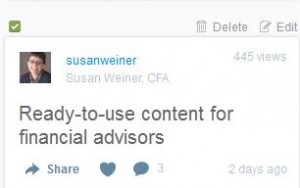Social media and digital marketing for investment managers
Darien Gould did a great job hosting my webinar on investment blogging for the Third Party Marketing Association last summer. I was intrigued by the statistics she found on social media marketing by investment management firms, so I asked her to blog about the topic. The guest post below is the result.
I’m particularly taken with Darien’s point that social media and digital marketing can help small firms compete against larger firms. In the world of financial blogging, I’ve noticed how smaller firms can show more personality than their larger peers. Smaller firms are also often nimbler in dealing with compliance.
Darien and I would love to hear if these statistics and suggestions match up with your experience in this arena.
Can social media and digital marketing be effective for investment manager marketing?
By Darien Gould
Digital marketing and social media were hot topics at the eWomen Network entrepreneur conference I attended last summer. But as a marketing consultant I have heard investment managers express a lot of resistance to social media. They typically use digital media only as an electronic substitute for paper marketing materials, and web pages are often only brochures about the firm. This made me wonder, can social media and digital marketing be effective for investment manager marketing?
After the conference, I did a quick survey of information online. I found that the answer is yes! Social media and digital marketing can really benefit investment managers—and give smaller firms an edge over their competitors.
Reports from Peregrine Communications and Greenwich Associates show that institutional investors and consultants increasingly use digital and social content to research and track managers. If you’re not active in these arenas, you’re hurting your visibility.
Statistics from Peregrine Communications
Here are highlights from Peregrine’s 2018 Connected Content, as reported in Peregrine’s BEST PRACTICE: Hidden Habits of the Best Asset Management Communicators:
- Seasonality: Traffic from institutional investors to investment manager websites was seasonal. Compared with the average number of visits, manager websites enjoyed more than 26% more visits between August and October, and 29% more visits between December and February. Digital content on a website increases prospects’ interest in the company, and can lead to repeat visits. This makes it important to refresh your content more frequently during these five months.
- Effectiveness: Thought leadership and demonstrations of firm strengths can differentiate firms in the increasingly competitive fight for investor interest. The firms getting the most attention from prospect searches use client-centric terms like “solutions,” “services,” or “clients.” If you’re an investment manager, does your content focus on solving your clients’ problems?
- Social media: More than two thirds of institutional investors use LinkedIn for research. However, one in five asset managers has no presence on social media at all. This reinforces my suggestion that you can use social media and digital marketing to differentiate your firm from your competitors’ firms.
Statistics from Greenwich Associates
Greenwich Associates’ study, Investing in the Digital Age, yielded insights into the use of social media in the investment process and its impact on investment decisions:
- 63% of institutional investors now consume social media while less than half consume finance-specific publications.
- 58% of respondents use social media to seek support or service from their asset manager.
- LinkedIn is the most thought-of provider of personalized market information.
Step up to digital and social media marketing!
My conclusions? Compliance and legal concerns don’t have to exclude all social media marketing. Reinforcing your firm’s brand and demonstrating your firm’s strengths through thought leadership don’t require discussion of performance or specific stock selections. And the same digital marketing that can interest prospects in your firm are also effective for highlighting your value to current clients.
These new marketing techniques level the playing field and allow even the smallest manager to compete for the attention of prospects against even the biggest investment firms.
I am curious, is your firm using digital marketing? What social media platforms do you use?
Learn more
You can follow my postings about investment marketing on Twitter at @DG_Analytics and on LinkedIn at linkedin.com/in/dganalytics. While you’re on Twitter, also check out postings from @PeregrineComms and @GreenwichAssociates.



